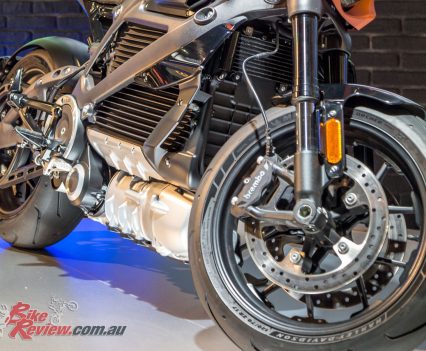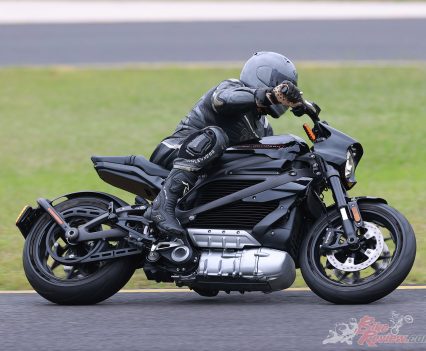We spend three days on track testing the LiveWire. Battery charge easily does 6 x 20min sessions and the results are a surprise... Test: Paul Bailey Photography SDPics & HD
A few months ago I had the opportunity to take home a Harley-Davidson LiveWire while my 2018 Softail deluxe was in for a service at Fraser Motorcycles Concord. After riding the LiveWire around, I knew I had to at least try to get the bike for a track test… So I did three!

The LiveWire tackled the corner exits with ease thanks to its instant power delivery from the electric motor.
I actually didn’t have to try that hard, Warren Fraser and I have been friends for 30 odd years and the dealer manager was also OK with the idea. Mind you, I do manage the the ride days at Sydney Motorsport Park Ride Days and I’ve been riding and racing for 50 years…
It turned out I had the LiveWire for three days near the end of December so I had plenty of time to set it up for the track and do some laps. There were a heap of modes and setting to choose from, it allowed me to find a setup that I really felt comfortable with and continue to build on it.

“The suspension is very good quality Showa suspension …. and a Balance Free Rear Cushion Lite Shock.”
Setup for fast track work is essential if you really want to get the maximum potential from a bike. The LiveWire is no different. The suspension is very good quality Showa suspension with 43mm inverted Separate Function Fork – Big Piston (SFF-BP) and a Balance Free Rear Cushion Lite (BFRC-lite) shock. Once dialled in for the track rather than the road settings, the handling was excellent.
Contributing to the great handling are the Michelin Scorcher Sport tyres, which allow for easy turn-in due to their high-performance sidewall design.
Shod on 17-inch cast aluminum five-spoke wheels that look very Marchesini-ish, the sizes are 120/70 and 180/55. This means you’ll have plenty of options available to you should the Michelin’s not meet your needs.
There are also Brembo radial mount calipers on the front forks with braided lines and 310mm floating discs. It all worked so well pulling up the bike as well as any conventional nakedbike would, strong predictable brakes all session every session. The front setup did a great job pulling the LiveWire up, particularly into the tight turns 2 and 9, where lap after lap there was fade free performance and good feel and modulation. There was excellent feel from the tyres and suspension.
The LiveWire is a heavy bike but has a low centre of mass, which makes the bike feel much lighter than it is when tipping into turns. The low mass also aided the heavy braking under extreme conditions, by keeping the bike super stable…
Check out our launch report on the LiveWire here…
So with the handling sorted it was time to play with the power modes on the bike, SPORT is obviously the one for track duties. With a predicted range in sport of 180km, (this is shown on the dash as a battery line along the bottom of the screen), I was very keen to see how that would last during a day on track. The SMSP track days are run with six sessions for each skill level group, so a maximum of 6 x 20min sessions is what I was looking at.

180km of range while in sport mode could have some draw backs while out on track as it does take a while to charge.
I decided to fiddle with the traction control before heading out on track as it’s simple to adjust, just a swipe of your finger along the dash and you can change from maximum to minimum. I did start off with the default setting until I felt comfortable with the bike and the instant power of the electric motor, but by day two I had it all the way to minimum. You can feel the difference and it does make the bike feel more alive and less restricted with throttle openings.
It has what H-D calls the Reflex Defensive Riding System—a collection of tech that optimises traction during acceleration, deceleration, and braking, with all available during cornering. I tried breaking the rear loose on some wetter corners and slammed on the brakes in a few mockup emergency stops. The riding aid systems work exactly as they should, and with little detection of engagement. The ABS is not switchable, though the traction control can be deactivated by a simple push of a button while at a stop.
The fully charged battery lasted all day with six sessions being completed in Sport Mode, there was still between 35 per cent to 42 per cent charge left at the end of the day…
The integration of the following electronics is seamless, even if the trade names are awkward:
- Cornering Enhanced Antilock Braking System (C-ABS): The brake pressure required to initiate wheel slip when cornering is typically lower than the pressure required under straight-line operation. This system adjusts for that.
- Rear-wheel Lift Mitigation: This system utilises the C-ABS sensors and the six-axis inertial measurement unit (IMU) to manage rear-wheel lift during heavy braking and further balance deceleration and rider control.
- Cornering Enhanced Traction Control System (C-TCS): Designed to prevent the rear wheel from excessive spinning under acceleration when going straight or cornering.
- Drag-Torque Slip Control System (DSCS): Designed to manage rear-wheel slip and prevent rear-wheel lock during regenerative braking, which may occur when the rider decelerates on wet or slippery road.
All this technology is so nice to have and know that you have it with the LiveWire, why you might ask? Because this bike has some serious power and acceleration! On paper it doesn’t seem like a lot of horsepower or torque.
The LiveWire has a 105hp and 86ft/lbs@0rpm.
Yes, all power is immediately available, which helps accelerate this Harley EV from 0 to 100km/h in 3 seconds, and 100 to 140km/h in 1.9 seconds. Of course, software softens the response to make the motor usable. Ever turned on an electric angle grinder? You don’t want a light switch delivery of power.
The EV engine is called Revelation by Harley-Davidson and is an internal permanent magnet synchronous motor with water jacket cooling. It spins up to 15,000rpm. I saw a top speed of 185km/h on both the back straight and front straight at SMSP. It’s a bit slow for the 1km long front straight, reaching its 185km/h well before the start/finish line. Around the rest of the track it is lightening quick with acceleration that matches 1000cc bikes of five or six years ago.
There was very little that could beat the LiveWire up the back straight at SMSP, it is just so fast out of the corners it makes you laugh under your helmet. There is no doubt far more potential for higher speeds as I’m sure the electric motor is no where near its peak revs at that speed.
By the end of three days of playing with the LiveWire I was totally impressed by the power, handling and braking, it’s a first class sports naked in every sense of the word. The charging system and battery was also impressive. The fully charged battery lasted all day with six sessions being completed in Sport Mode, there was still between 35 per cent to 42 per cent charge left at the end of the day.
Check out our other Harley Davidson tests here…
To charge it up on 240V main power all I had to do was unlock the seat and remove the charger and plug it into the fitting on the middle of the dummy fuel tank, same set up as the Tesla charging stations, and plug the other normal three pin lead into a normal power outlet. Turn it on and let it charge up overnight, next morning, full charge again for another day of riding.
We all have a viewpoint on electric bikes with the benefits and limitations of charging the battery, but in the environment of a track day this LiveWire was and is a sensation. It does not have to be an urban toy for the commuter to feel happy about his or her carbon footprint. It can be a serious bike for track days or dare I say it? Racing in the EV race series in this country and around the world.

“I was left surprised at how well the LiveWire tackled a big track like SMSP despite the speed limiter.”
Run it as a nakedbike or fit full fairings to it, this bike could be very competitive. I’m sure it won’t be long till someone works out a way to get rid of the speed limiter but on shorter tracks like Wakefield, Broadford, Winton and others that don’t have long straights this bike would really cause some reactions among the established fuel bikes.
2020 Harley Davidson LiveWire Specifications
Price: $49,995R/A
Colours: Vivid Black, Yellow Fuse, Orange Fuse
Claimed power: 78kW [105hp]@10000rpm
Claimed torque: 116Nm [86ft-lb)
Wet weight: 251kg
Fuel capacity: Er, it’s black magic!
Engine: Water-cooled Revelation permanent magnet electric motor, single speed
Battery: 24kWh
Range: 235km Claimed (City)
Chassis: Cast alloy
Rake: 24.5°
Trail: 108mm
Suspension: USD Showa SFF-BP forks, fully adjustable,114mm travel, Showa BFRC shock, fully adjustable, 114mm travel
Brakes: ABS, four piston radial-mount Brembo monoblock front calipers, 300mm dual rotors (f), single 260mm floating rear rotor, dual-piston caliper (r), ABS
Wheels & Tyres: Cast alloy five-spoke, HD Michelin Scorcher Sport , 120/70–17in (f), 180/5–17in (r)
DIMENSIONS:
Wheelbase: 1490mm
Ground clearance: 130mm
Seat height: 780mm
Overall height: N/A
Overall length: 2135mm
Overall width: N/A
Instruments: Full digital TFT multi-function display, Bluetooth connectivity via H-D Connect app.
The Verdict | Racetrack Test: Harley-Davidson LiveWire, Charged!


































February 26, 2021
Interesting article, as someone who races ICE powered bikes did u not miss the interaction between, u, the gearbox and clutch, being able to match engine speed with the right gear at the right time is one of the key skills for a motorcycle racer, on the livewire u don’t have any of that, it’s just twist, go ,brake , surely some of that skill and the fun factor of racing is then lost?